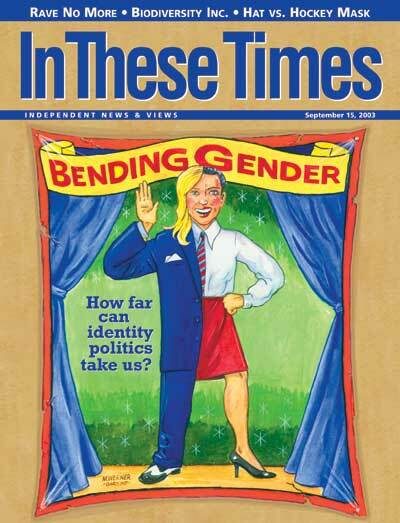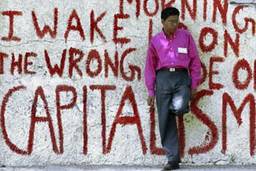
India’s deepening ties with Iran could redraw the political map of Central Asia, even as the Bush administration commences what some say is an attempt at regime change in Tehran.
On May 18, U.S. Defense Secretary Donald Rumsfeld warned Iran that it would be “dealt with aggressively” if it continued its alleged support of Islamic extremists in Afghanistan and Iraq. A day later in New Delhi, Indian Defense Minister George Fernandes met with Iranian Ambassador Siavosh Yaghoobi and offered to cooperate with Iran in all strategic areas, including defense. Saying that unilateralism posed a great danger to the world, Fernandes affirmed India’s commitment to a strategic and military partnership with Iran.
The move capped a series of quiet diplomatic maneuvers that have complicated security equations in Central and South Asia. Even as Washington has been building military ties with India, which it sees as a natural ally and potential counter to China, New Delhi has been forging a close relationship with Iran, which President Bush has declared a part of the “axis of evil.”
On January 26, in the shadow of the then-looming Iraq war, Iranian President Mohammad Khatami was the guest of honor at India’s grand Republic Day parade. During the visit the two nations signed a strategic cooperation agreement that set in place energy and military deals valued at more than $25 billion.
Jane’s Defense Weekly and Defense News reported that India and Iran signed a secret accord that gives India access to Iranian bases in the event of war with Pakistan. Both governments deny there is such a deal, but India is building a new port at Chahbahar, Iran, a project that is being closely watched by foreign powers.
In March, India and Iran conducted their first-ever joint naval exercises. Such close military cooperation between India and Iran is “unprecedented,” says Rahul Bedi, New Delhi-based correspondent for Jane’s Defense Weekly. India and Iran were on opposite sides during the Cold War, and later their relations were compromised by Iran’s fraternal ties with Islamic Pakistan.
Iran is “focused on breaking out of the pincer” that the United States’ continuing trade embargo and its expanded military presence in the region have created, Bedi says. “Iran is keen to acquire new energy markets,” he adds. Militarily, it “is seeking to build up its missile and military software capabilities. It has also acquired four Russian Kilo-class submarines, and, like India, it also has some aging MiGs that need upgrading. Given the common equipment, [the Iranians] are keen to have India support and train them.”
But the deepest concern to the U.S. and Pakistani governments is the possibility of Indo-Iranian nuclear cooperation. India and Russia have a long history of nuclear cooperation, and Russia is the key player in Iran’s controversial bid to expand its German-built light water reactor at Bushehr. According to the CIA, Iran is also operating a heavy water plant at Arak and a uranium enrichment facility at Natanz.
In 1983 India helped Iran restart its nuclear program, and in 1988 New Delhi almost sold Iran a 10-megawatt nuclear reactor for its Ma’allem Kelayah facility near Qazvin on the Caspian Sea. When that deal fell through, the CIA reported that India helped Iran set up a manufacturing plant for phosphorus pentasulfide, a nerve gas precursor, at the same site. In 1996, the CIA also reported that India had provided Iran with technology that could be used to make biological weapons. When three Indian companies approached German suppliers to buy the equipment needed for the manufacture of Sarin and Tabun nerve agents, German intelligence traced the end-user to Iran.
Anthony H. Cordesman, a senior fellow at the Center for Strategic and International Studies and author of the report Iran and Nuclear Weapons, writes that Tehran is seeking increased nuclear cooperation with India and other suppliers because the United States has nixed its nuclear cooperation with South Africa, Ukraine, Argentina, and China. Iran’s options were further squeezed when Russia supported the Bush administration’s call for intrusive inspections of Iran’s nuclear facilities.
But even if Indo-Iranian nuclear cooperation seems logical, Bedi argues, it is unlikely. “India is not a proliferating country,” he says. “This fact is well established.” Indian government officials enjoy pointing out that it was the United States that built Iran’s first nuclear plant at Amirabad, and then turned a Nelson’s eye when the Shah initiated a low-grade weapons research program in 1967.
Instead Bedi, like many analysts, sees an Indo-Iranian alliance as a stabilizing force in the region and in accord with the long-term interests of the United States.
“India and Iran’s cooperation began in Afghanistan, where their support was key in overthrowing the [Pakistan-supported] Taliban,” Bedi says. “Their continued cooperation will promote the stabilization and development of Central Asia. Perhaps India can also act as a bridge between Iran and the United States.”
For now it is a bridge that the United States is unlikely to cross. Though the administration’s initial reaction to burgeoning Indo-Iranian ties was circumspect, and President Bush couched his concerns in soft language, the war in Iraq has changed attitudes.
Anxiety over Iran’s alleged attempts to create an Islamic republic in Shia-dominated Iraq has once again flared tensions with Washington. An increased U.S. presence in the region is also making both Iran and India uncomfortable.
In addition to Iran’s obvious concerns, Indian Prime Minister Atal Bihari Vajpayee has also voiced unease over the United States’ aggressive posture in the region. Speaking at a rally in Kashmir, he pointed to American intervention in Iraq as a reason for India and Pakistan to get serious about settling their dispute over the troubled state.
Syed Geelani, chairman of the Jamaat-e Islami, a separatist political party in Kashmir, says that the driving force behind the recent thaw in Indo-Pak relations “is not the desire to give Kashmiris their rights but the desire to keep the United States from meddling here in the name of terrorism.”
Publicly, both Iran and India have been trying to allay U.S. fears over their new relationship. “The text of our agreement clearly states that it is not directed against any other nation,” Ambassador Yaghoobi says of the rationale behind India and Iran’s strategic cooperation.
India’s foreign ministry says it refuses to see international relations as a zero-sum game. “The United States has its relationship with Pakistan, which is separate from our own relationship with them,” says Navtej Sarna, the ministry spokesperson. “Our relationship with Iran is peaceful and largely economic. We do not expect that it would affect our continuing good relations with the United States.”
Diplomatic and official sources in India agree. They say the Indo-Iranian partnership stems from both nations’ longtime allergy toward the Saudi-funded fundamentalism gripping their common neighbor, Pakistan.
“India’s new ties with Iran make it more, not less, valuable to Washington,” says Stanley Weiss, chairman of Business Executives for National Security, which wants President George W. Bush to “join New Delhi and Tehran in an axis of friendship.”
“Both countries played a vital role in creating and sustaining the U.S.- backed government in Kabul, [and] the United States will need Iran to help stabilize a post-Saddam Iraq,” Weiss says. “New Delhi will also be an increasing asset to Washington thanks to its military partnership with Israel.”
But India and Iran’s growing involvement in Afghan politics, along with energy-hungry India’s establishment of its first overseas military base at Farkhor in Tajikistan, indicate both nations are pursuing their own interests in oil- and gas-rich Central Asia.
There is also a deeper, more profound layer to the relationship between India and Iran. Both nations see themselves as great civilizational forces and are eager to restore their primacy in the world.
As neighboring countries, India and Iran have deep historical ties dating to the Persian Empire of Cyrus the Great, which included parts of India. India’s latter-day Muslim rulers were of Persian descent, and Urdu, a mix of Hindi and Persian, is widely spoken in India. Iran’s Sufi Islam is substantially influenced by Indian thought, and many of India’s religious and cultural traditions owe great debts to Iran.
When discussing Indo-Iranian ties officials from both countries often allude to these civilizational bonds. “We are from the same motherland and share deep cultural links,” Yaghoobi says. “Though political differences separated us during the Cold War, President Khatami and Prime Minister Vajpayee have brought us back to our natural relationship.”
Clearly, the public aspects of the Indo-Iranian accord envisage widespread economic and strategic cooperation. Iran will provide India with 5 million tons of liquefied natural gas a year for the next 25 years, giving it much-needed revenue. Significantly, Indian firms will upgrade Iranian oil refineries and be granted concessions in Iranian oil fields. The possibility of constructing a $4 billion gas pipeline from Iran to India—possibly via Pakistan, if politics permit—is also being pursued.
“In effect, all this means that India is now a member of OPEC,” Yaghoobi says.
The January agreement also includes plans for India to construct a new road and rail network in Iran. Both countries will use this as a trade and transit route to get their goods into Russia and Europe.
Since Pakistan’s involvement will make both the pipeline and transit route much easier to build and operate, observers on all sides hope these projects will provide a strong incentive for India and Pakistan to resolve their disputes.
“This is a pipeline for peace,” Yaghoobi says. In the recent rapprochement with India, he explains, “Pakistan has given emphasis to commercial aspects of their bilateral relations. … Both need cheap energy, and so we hope this project will help them resolve their issues.”
“In the long run we hope for an economic bloc of India, Pakistan, Afghanistan, Iran, and maybe Central Asia,” Yaghoobi says. “Currently there is a gap between the Association of South East Asian Nations and the EU. As the only two democracies in the region, India and Iran can start a partnership to fill this gap.”
How the United States will accommodate such Indo-Iranian visions of a strategic region rich in energy and linking Europe with Asia is a prime example of what of Kennedy School of Government Dean Joseph Nye calls “the paradox of American power.” Even as America is equipped to pursue its interests unilaterally, it needs the cooperation of many nations with diverse, even conflicting, interests to ensure a stable world order.
On May 18, U.S. Defense Secretary Donald Rumsfeld warned Iran that it would be “dealt with aggressively” if it continued its alleged support of Islamic extremists in Afghanistan and Iraq. A day later in New Delhi, Indian Defense Minister George Fernandes met with Iranian Ambassador Siavosh Yaghoobi and offered to cooperate with Iran in all strategic areas, including defense. Saying that unilateralism posed a great danger to the world, Fernandes affirmed India’s commitment to a strategic and military partnership with Iran.
The move capped a series of quiet diplomatic maneuvers that have complicated security equations in Central and South Asia. Even as Washington has been building military ties with India, which it sees as a natural ally and potential counter to China, New Delhi has been forging a close relationship with Iran, which President Bush has declared a part of the “axis of evil.”
On January 26, in the shadow of the then-looming Iraq war, Iranian President Mohammad Khatami was the guest of honor at India’s grand Republic Day parade. During the visit the two nations signed a strategic cooperation agreement that set in place energy and military deals valued at more than $25 billion.
Jane’s Defense Weekly and Defense News reported that India and Iran signed a secret accord that gives India access to Iranian bases in the event of war with Pakistan. Both governments deny there is such a deal, but India is building a new port at Chahbahar, Iran, a project that is being closely watched by foreign powers.
In March, India and Iran conducted their first-ever joint naval exercises. Such close military cooperation between India and Iran is “unprecedented,” says Rahul Bedi, New Delhi-based correspondent for Jane’s Defense Weekly. India and Iran were on opposite sides during the Cold War, and later their relations were compromised by Iran’s fraternal ties with Islamic Pakistan.
Iran is “focused on breaking out of the pincer” that the United States’ continuing trade embargo and its expanded military presence in the region have created, Bedi says. “Iran is keen to acquire new energy markets,” he adds. Militarily, it “is seeking to build up its missile and military software capabilities. It has also acquired four Russian Kilo-class submarines, and, like India, it also has some aging MiGs that need upgrading. Given the common equipment, [the Iranians] are keen to have India support and train them.”
But the deepest concern to the U.S. and Pakistani governments is the possibility of Indo-Iranian nuclear cooperation. India and Russia have a long history of nuclear cooperation, and Russia is the key player in Iran’s controversial bid to expand its German-built light water reactor at Bushehr. According to the CIA, Iran is also operating a heavy water plant at Arak and a uranium enrichment facility at Natanz.
In 1983 India helped Iran restart its nuclear program, and in 1988 New Delhi almost sold Iran a 10-megawatt nuclear reactor for its Ma’allem Kelayah facility near Qazvin on the Caspian Sea. When that deal fell through, the CIA reported that India helped Iran set up a manufacturing plant for phosphorus pentasulfide, a nerve gas precursor, at the same site. In 1996, the CIA also reported that India had provided Iran with technology that could be used to make biological weapons. When three Indian companies approached German suppliers to buy the equipment needed for the manufacture of Sarin and Tabun nerve agents, German intelligence traced the end-user to Iran.
Anthony H. Cordesman, a senior fellow at the Center for Strategic and International Studies and author of the report Iran and Nuclear Weapons, writes that Tehran is seeking increased nuclear cooperation with India and other suppliers because the United States has nixed its nuclear cooperation with South Africa, Ukraine, Argentina, and China. Iran’s options were further squeezed when Russia supported the Bush administration’s call for intrusive inspections of Iran’s nuclear facilities.
But even if Indo-Iranian nuclear cooperation seems logical, Bedi argues, it is unlikely. “India is not a proliferating country,” he says. “This fact is well established.” Indian government officials enjoy pointing out that it was the United States that built Iran’s first nuclear plant at Amirabad, and then turned a Nelson’s eye when the Shah initiated a low-grade weapons research program in 1967.
Shifting sands
Instead Bedi, like many analysts, sees an Indo-Iranian alliance as a stabilizing force in the region and in accord with the long-term interests of the United States.
“India and Iran’s cooperation began in Afghanistan, where their support was key in overthrowing the [Pakistan-supported] Taliban,” Bedi says. “Their continued cooperation will promote the stabilization and development of Central Asia. Perhaps India can also act as a bridge between Iran and the United States.”
For now it is a bridge that the United States is unlikely to cross. Though the administration’s initial reaction to burgeoning Indo-Iranian ties was circumspect, and President Bush couched his concerns in soft language, the war in Iraq has changed attitudes.
Anxiety over Iran’s alleged attempts to create an Islamic republic in Shia-dominated Iraq has once again flared tensions with Washington. An increased U.S. presence in the region is also making both Iran and India uncomfortable.
In addition to Iran’s obvious concerns, Indian Prime Minister Atal Bihari Vajpayee has also voiced unease over the United States’ aggressive posture in the region. Speaking at a rally in Kashmir, he pointed to American intervention in Iraq as a reason for India and Pakistan to get serious about settling their dispute over the troubled state.
Syed Geelani, chairman of the Jamaat-e Islami, a separatist political party in Kashmir, says that the driving force behind the recent thaw in Indo-Pak relations “is not the desire to give Kashmiris their rights but the desire to keep the United States from meddling here in the name of terrorism.”
Publicly, both Iran and India have been trying to allay U.S. fears over their new relationship. “The text of our agreement clearly states that it is not directed against any other nation,” Ambassador Yaghoobi says of the rationale behind India and Iran’s strategic cooperation.
India’s foreign ministry says it refuses to see international relations as a zero-sum game. “The United States has its relationship with Pakistan, which is separate from our own relationship with them,” says Navtej Sarna, the ministry spokesperson. “Our relationship with Iran is peaceful and largely economic. We do not expect that it would affect our continuing good relations with the United States.”
Diplomatic and official sources in India agree. They say the Indo-Iranian partnership stems from both nations’ longtime allergy toward the Saudi-funded fundamentalism gripping their common neighbor, Pakistan.
“India’s new ties with Iran make it more, not less, valuable to Washington,” says Stanley Weiss, chairman of Business Executives for National Security, which wants President George W. Bush to “join New Delhi and Tehran in an axis of friendship.”
“Both countries played a vital role in creating and sustaining the U.S.- backed government in Kabul, [and] the United States will need Iran to help stabilize a post-Saddam Iraq,” Weiss says. “New Delhi will also be an increasing asset to Washington thanks to its military partnership with Israel.”
But India and Iran’s growing involvement in Afghan politics, along with energy-hungry India’s establishment of its first overseas military base at Farkhor in Tajikistan, indicate both nations are pursuing their own interests in oil- and gas-rich Central Asia.
There is also a deeper, more profound layer to the relationship between India and Iran. Both nations see themselves as great civilizational forces and are eager to restore their primacy in the world.
As neighboring countries, India and Iran have deep historical ties dating to the Persian Empire of Cyrus the Great, which included parts of India. India’s latter-day Muslim rulers were of Persian descent, and Urdu, a mix of Hindi and Persian, is widely spoken in India. Iran’s Sufi Islam is substantially influenced by Indian thought, and many of India’s religious and cultural traditions owe great debts to Iran.
When discussing Indo-Iranian ties officials from both countries often allude to these civilizational bonds. “We are from the same motherland and share deep cultural links,” Yaghoobi says. “Though political differences separated us during the Cold War, President Khatami and Prime Minister Vajpayee have brought us back to our natural relationship.”
Pipeline for peace?
Clearly, the public aspects of the Indo-Iranian accord envisage widespread economic and strategic cooperation. Iran will provide India with 5 million tons of liquefied natural gas a year for the next 25 years, giving it much-needed revenue. Significantly, Indian firms will upgrade Iranian oil refineries and be granted concessions in Iranian oil fields. The possibility of constructing a $4 billion gas pipeline from Iran to India—possibly via Pakistan, if politics permit—is also being pursued.
“In effect, all this means that India is now a member of OPEC,” Yaghoobi says.
The January agreement also includes plans for India to construct a new road and rail network in Iran. Both countries will use this as a trade and transit route to get their goods into Russia and Europe.
Since Pakistan’s involvement will make both the pipeline and transit route much easier to build and operate, observers on all sides hope these projects will provide a strong incentive for India and Pakistan to resolve their disputes.
“This is a pipeline for peace,” Yaghoobi says. In the recent rapprochement with India, he explains, “Pakistan has given emphasis to commercial aspects of their bilateral relations. … Both need cheap energy, and so we hope this project will help them resolve their issues.”
“In the long run we hope for an economic bloc of India, Pakistan, Afghanistan, Iran, and maybe Central Asia,” Yaghoobi says. “Currently there is a gap between the Association of South East Asian Nations and the EU. As the only two democracies in the region, India and Iran can start a partnership to fill this gap.”
How the United States will accommodate such Indo-Iranian visions of a strategic region rich in energy and linking Europe with Asia is a prime example of what of Kennedy School of Government Dean Joseph Nye calls “the paradox of American power.” Even as America is equipped to pursue its interests unilaterally, it needs the cooperation of many nations with diverse, even conflicting, interests to ensure a stable world order.
Jehangir Pocha is the Asia correspondent for In These Times.







